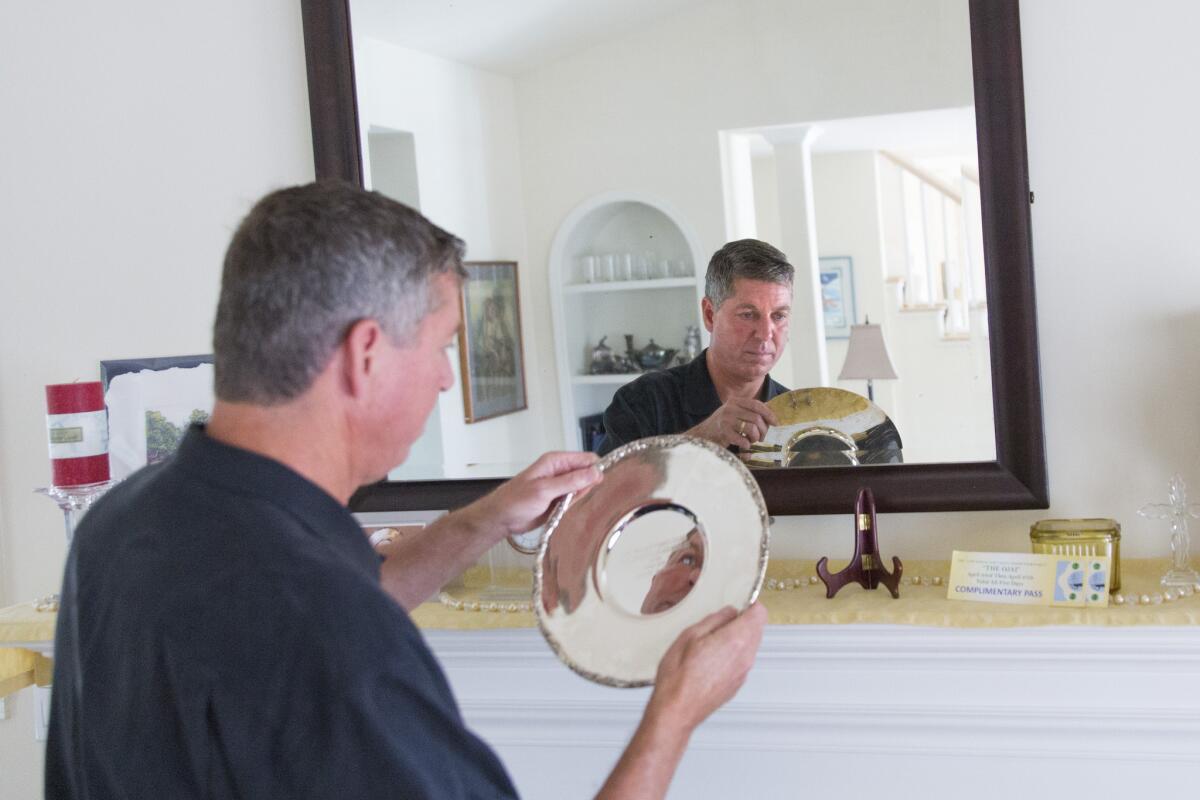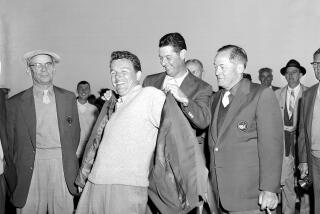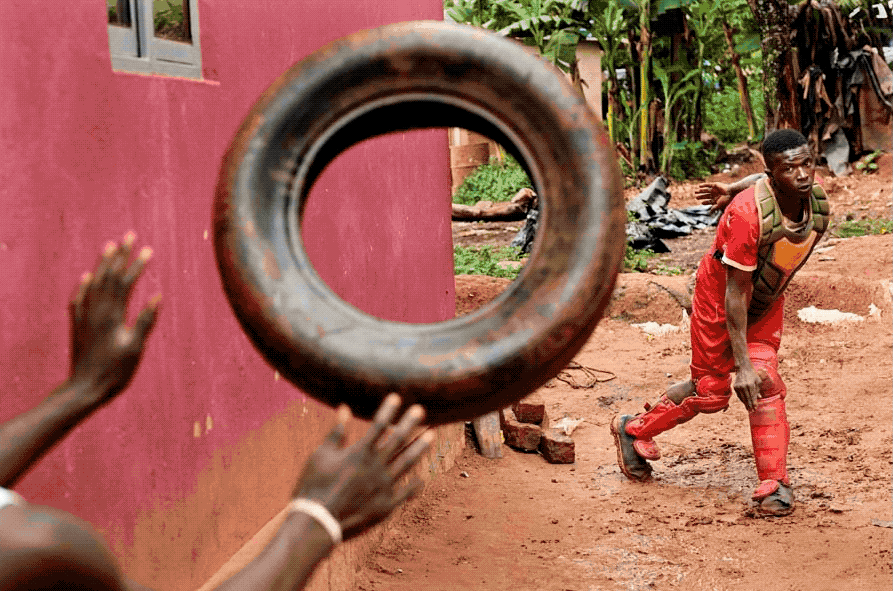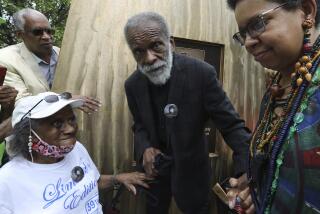Great Read: Unmarked trophy serves clue to lost tennis champion

On a cluttered card table at a Westside estate sale, Sandy Marks spotted an antique silver trophy. It was a large bowl, so deeply tarnished that she struggled to read the inscription:
Ojai Valley Tennis Club
Men’s Intercollegiate Singles Champion
1938
Won by
The winner’s name had never been filled in. But Marks, who regularly resells used goods on eBay, knew there was a market for old trophies. She paid $10 that day in December and promptly put the trophy up for auction.
The winning bidder, an L.A. tennis buff, paid $65 for it and donated it to the Ojai tournament, which is still played every spring.
“Nobody knew who the 1938 champion was,” said Steve Pratt, the tournament’s marketing chief. “So I did some digging and found out the winner that year was a pretty big deal. Turns out this was one of the great tennis champions, could’ve been the greatest of champions, but nobody really remembered him or what he’d done. I mean, who in the world ever heard of Joe Hunt?”
::
Joe Hunt was born in San Francisco on Feb. 17, 1919, the youngest son of a lawyer and his homemaker wife. When he was 10, his family moved to Los Angeles, settling in a brick-faced Tudor near Hancock Park.
Tennis was in his blood — his father had been state champion just after the century’s turn — and he took to the game with a fluid ease.
By 15, the young player with the matinee-idol looks was part of a crew of hotshots that included Jack Kramer and Bobby Riggs, who would become icons in the sport. The trio practiced regularly at the Los Angeles Tennis Club, tucked inconspicuously then in the same place it is now, off Melrose Avenue, just a few forehand drives from Paramount Studios.
“The L.A. Tennis Club was like a laboratory,” Kramer reminisced in an autobiography. “If you wanted competition, you had to play there.”
Joe Hunt began building a resume that suggested he could be the best of the bunch: national boys champion, national junior men’s champion, Ojai champion and winner at USC of the 1938 national college doubles crown.
“He was a great player and very handsome,” recalled Pancho Segura, now 93 and among the few stars of Hunt’s era still living. “A big, blond, all-American guy who looked like Charles Atlas out there. He also had table manners, you know what I mean? Knew how to use the fork and knife. The upper crust.”
The game was different then, played in long white pants or pleated shorts by competitors using cumbersome wooden rackets and strings made of animal intestines. There wasn’t a big-time pro circuit; even grand slams such as Wimbledon and the U.S. Championships were amateur endeavors without prize money.
Still, in a Los Angeles before the Lakers or the Dodgers, before the advent of television and the introduction of million-dollar checks, tennis was among the most popular sports — nowhere more than with the dashing movie crowd.
Hunt and the others became favorites with a stream of A-list film stars. At the club, he could look into the stands and spot an Errol Flynn or a Bing Crosby, a Ginger Rogers or a Jean Harlow, watching his every shot.
“I recall it all being very glamorous, this mix of tennis and the stars, Errol and all the others,” said Welby Van Horn, another 93-year-old great of the era, speaking haltingly over the telephone from a Florida nursing home. “From the L.A. Club we would be invited to those movie-star homes and we’d play tennis with them at their courts. They loved tennis and wanted to be around us.”
But by 1940, war loomed, and everything changed.
::
Looking for the best way to serve his country, Hunt transferred from USC to the Naval Academy in Annapolis, Md.
“There’d never been a bigger star here,” said John Moreland, a Naval tennis coach who researched Hunt’s past. Hunt was such a good athlete he made the Navy football team. In tennis, he won the national intercollegiate singles crown.
After Pearl Harbor, Hunt’s class graduated early and served on destroyers in the Pacific and the Atlantic. In 1943, he petitioned for a short leave so he could play the U.S. National Championships — the equivalent of today’s U.S. Open — held then at Forest Hills in New York City.
There was uncertainty over whether the tournament could even be played that year. Most of the top American players were in the military. Rubber rationing made it hard to find enough tennis balls. Travel was tough, because gasoline was scarce.
But the event went on, and Hunt plowed to the finals against Kramer, who’d been granted leave from the Coast Guard. Hunt won 6-3, 6-8, 10-8, 6-0, a match played on grass and punctuated by a remarkable climax: Kramer misfiring as Hunt fell to the ground with leg cramps.
It would be the last great match of Hunt’s life. Ranked No. 1 in the nation, he was feted weeks later by Bob Hope at a Biltmore Hotel gala put on by the L.A. Times. He headed back to the military, training to be a fighter pilot.
On Feb. 2, 1945, during a practice run off the east coast of Florida, his Grumman Hellcat went into a tailspin at 10,000 feet, shattering as it slammed into the ocean. Hunt was 25.
Radio buzzed with the story. The Times ran a stark headline: “Lt. Joe Hunt Killed in Plane Crash: Tennis Ace Perishes Off Florida.” Allison Danzig at the New York Times movingly wrote:
“Every fine young life snuffed out in the daily grist of war brings tragedy to some home and grief to many.... The loss of Joe Hunt happens to bring this home to the writer of these lines more than has any other. Here was a youth who represented the finest in young manhood. Physically he was an Apollo, magnificently proportioned and strikingly handsome in a masculine way, with the jaw of a fighter. No finer specimen of an athlete has been seen at Forest Hills stadium.”
::
As Pratt, the Ojai tournament marketing chief, began uncovering more details about Hunt, he grew convinced the old trophy needed to find its proper home — with the tennis star’s family.
He got some leads from an old Sports Illustrated story and began cold-calling. Eventually he reached a Seattle lawyer who’d been named in the champion’s honor.
This Joe Hunt, now 55, had grown up entranced by a great-uncle he never knew, spending hour after hour as a kid poring over thick scrapbooks lined with yellowed newspaper articles about the man whose name he shared.
This Joe Hunt played tennis too, if at a lower level, for the University of Redlands team. Growing up, the old-timers would tell him how important his great-uncle had been. Then they began to die off, and with them the memories.
About a decade ago, Hunt began a more concerted effort to research his great-uncle, diving through Internet archives, compiling a detailed, 90-page listing of Joe Hunt tennis matches. In 2005, he flew to Los Angeles to meet Kramer for the first time.
“Jack was so gracious,” he said. “He told me, ‘When Joe Hunt died, I lost not only my friend, but one of my greatest rivals. If not for what happened, it would have been me and Joe fighting for No. 1 for years after the war.’ It made me very proud, but also sad; all the possibility that went down with that plane in the ocean.”
Hunt began a letter-writing campaign, trying to garner support from the panel of journalists who vote each year on who should be added to the U.S. Open Court of Champions, along with greats such as Kramer, Arthur Ashe and Billie Jean King.
The effort seemed stuck in neutral. Then Marks stumbled upon the old trophy, which found its way to Pratt. On a warm evening in April, Hunt stood at Libbey Park in Ojai, beaming as he was presented his great-uncle’s silver chalice.
Tennis Channel and USA Today ran stories. Officials at the United States Tennis Assn. headquarters in New York took note.
“Before all this happened, I have to admit, even here we didn’t really know who Hunt was,” said Chris Widmaier, the USTA’s communications director. “We quickly realized we needed to find a way to recognize a champion who died for our country and also won our national title.”
Given the shortness of his career, the odds appear long against Hunt entering the Court of Champions. But on Labor Day, 69 years after his death, he will be honored during a ceremony at the U.S. Open, part of the tennis association’s Military Appreciation Day.
A video will run on the big screens at Arthur Ashe Stadium. Joe Hunt, the lawyer, will be a guest, along with his family.
“I will probably break down,” he said. “All these years, we’ve wondered about him, wanted to know more about him, cared deeply about him.... And now, he is finally getting his due.”
Twitter: @kurtstreeter
More to Read
Sign up for Essential California
The most important California stories and recommendations in your inbox every morning.
You may occasionally receive promotional content from the Los Angeles Times.











